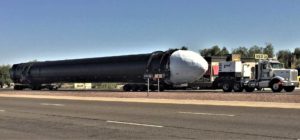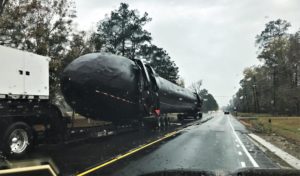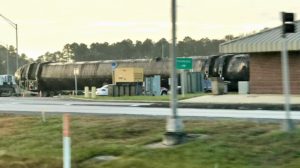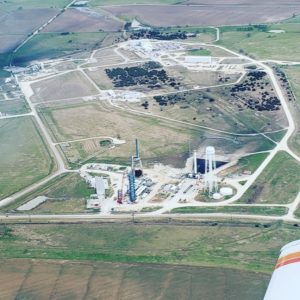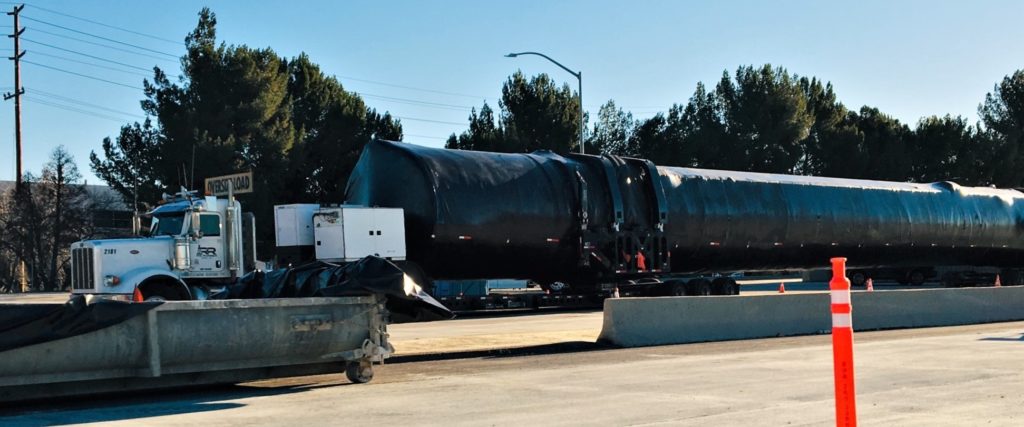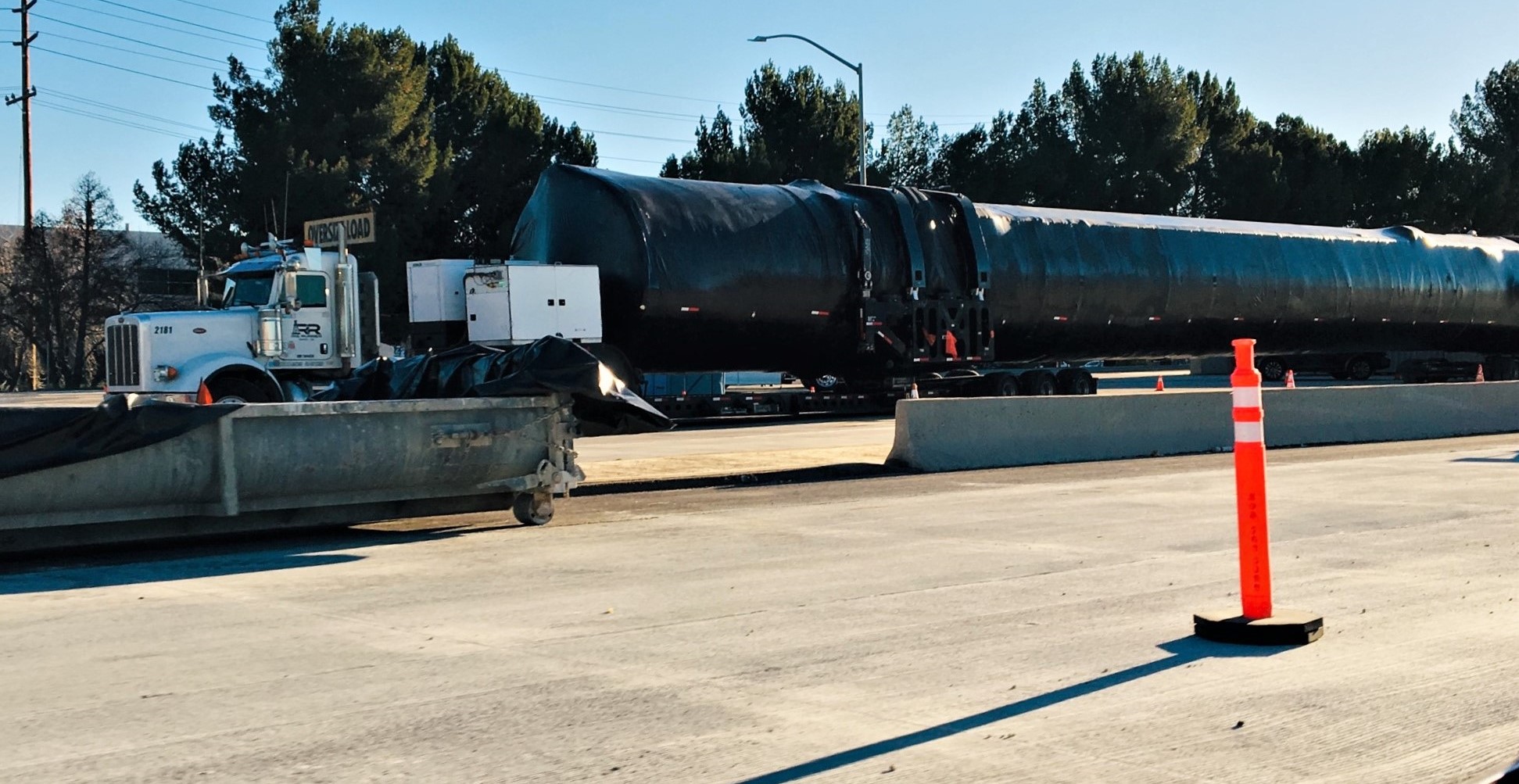

News
SpaceX Falcon 9 booster spied on highway as triple-satellite launch moves right
A SpaceX Falcon 9 booster was spotted heading north from the company’s Hawthorne, California factory on January 22nd, signifying a likely shipment of the flight-proven rocket that will help launch Canada’s trio of Radarsat Constellation Mission satellites.
Delayed from mid-February to early March 2019 after an unplanned landing anomaly damaged the Falcon 9 originally assigned to the mission, the shipment of a different booster to Vandenberg Air Force Base (VAFB) helps to narrow down the rocket now likeliest to launch the Canadian Space Agency’s (CSA) radar satellite constellation.
https://twitter.com/GoForStaging/status/1088174203298230272
Do the Booster Shuffle!
Thanks to a hydraulic pump failure that led Falcon 9 B1050 to land (albeit softly and in one piece) in the Atlantic Ocean last December, the imminent launch of two booster-dense Falcon Heavy missions, and the thus far schedule-shy orbital launch debut of Crew Dragon, SpaceX’s fleet of available boosters – all flight-proven – can be succinctly summarized as “B1046 thru B1049”.
B1050’s future is uncertain after suffering a smashed interstage and soaking in salt water for several days, while B1051 is definitively assigned to Crew Dragon’s orbital launch debut, known as Demo-1 (DM-1). Falcon 9 B1052 and B1053 are unknown quantities and B1054 was expended after a high-value US Air Force launch, also SpaceX’s final mission of 2018. It’s probably safe to bet that B1052, B1053, and B1055 will be the next three boosters to support a Falcon Heavy launch (or two), currently NET March and April 2019. All three of those Falcon Heavy (FH) boosters have completed static fire tests in Texas and both side boosters arrived at SpaceX’s Florida facilities within the last ~6 weeks.
- A Falcon Heavy side booster was spotted eastbound in Arizona on November 10th. (Reddit – beast-sam)
- The second (and third) flight of Falcon Heavy is even closer to reality as the first new side booster heads to Florida after finishing static fire tests in Texas. (Reddit /u/e32revelry)
- Reddit user wedatsaints captured this photo of the second Falcon Heavy side booster traveling through Mississippi on Jan 16. (Reddit /u/wedatsaints)
- SpaceX Facebook group member Joshua Murrah captured the second Falcon Heavy side booster to arrive in Florida in the last month. (Joshua Murrah, 01/17/19)
- A booster – likely the next Falcon Heavy center core – was vertical at McGregor’s S1 static fire stand. (Instagram /u/tcryguy)
Assuming that Falcon Heavy Flight 2 and 3 use the same exact boosters, SpaceX production technicians and engineers may already be nearing the completion of another Falcon 9 booster (B1056, presumably) at the Hawthorne factory, although they are likely 1-2 weeks away from that milestone. If, Falcon Heavy Flight 3 (presumed to be the USAF’s STP-2 mission) does not reuse all three first stage boosters from Flight 2 (commercial payload Arabsat 6A), then Hawthorne will have to build, ship, and test anywhere from 1-3 additional boosters between now and April 2019. In the latter scenario, all unflown – mid-build or completed – Falcon boosters would be ‘claimed’ between now and March or April.
Put in another way, short of opting for a delay that could stretch 1-4 months or longer, the Canadian Space Agency (CSA) and Radarsat prime contractor MDA will have to accept one of SpaceX’s flight-proven Falcon 9s.
Falcons on wheels
Thanks to SpaceX’s trusty and well-worn method of using good old trucks and roads to transport Falcon 9 and Heavy boosters, upper stages, fairings, landing legs, and much more cross-country, spaceflight fans have long taken advantage of opportunities – rare and fleeting as they might be – to spot and track SpaceX hardware on public roads. Put simply, a lot of people are excited about SpaceX or are at least familiar and curious enough to know someone to share a photo or observation with. As a result, the community averages dozens of ‘core spottings’ per year. With a little intuition, the process of elimination, a few sources, and some wild guesses, this allows unofficial fans to (very roughly) paint a picture of SpaceX’s fleet of rockets.
- Reddit user intamin1 spotted a Falcon 9 booster northbound between Hawthorne and Vandenberg on Jan 22. (Reddit /u/intamin1)
- A booster – likely the next Falcon Heavy center core – was vertical at McGregor’s S1 static fire stand. (Instagram /u/tcryguy)
For example, the Falcon 9 spotted in Valencia, CA on January 22nd by Reddit user intamin1 could theoretically be any SpaceX booster currently in existence. By knowing the rough state of SpaceX’s fleet (as described above) and observing that the booster was northbound between Hawthorne, CA (the factory) and Vandenberg Air Force Base (VAFB) on Jan 22, a great deal can be intuited. Bound for SpaceX’s West Coast launch complex (SLC-4), it ought to be flightworthy. Knowing that a Falcon Heavy center booster was on SpaceX’s McGregor, Texas static fire stand on January 10th means that the spotted booster can’t (or at least shouldn’t) be coming from Texas, as Falcon Heavy has no known launches planned from VAFB. The process of testing, inspecting, and preparing Falcon boosters for cross-country shipment is also not easily rushed.
On the East Coast, SpaceX needs to launch communications satellite PSN-6 and Spaceflight rideshare GTO-1 in mid to late February. With no new boosters expected to be easily available for months and PSN-6/GTO-1 already entering into the phases of payload fueling, integration, and fairing encapsulation, it can be all but guaranteed that a flight-proven booster was assigned to the mission months ago and is now nearly ready for its third flight somewhere in Cape Canaveral, FL.

Given that B1046 and B1049 are on the West Coast after conducting launches from VAFB and that B1050 is out of circulation for the time being, only B1047 and B1048 remain (in theory) on the East Coast, both having flown two missions. B1048 was recently spotted and confirmed in photos of SpaceX’s Pad 39A integration hangar, although Falcon 9 B1051 and the first orbit-ready Crew Dragon were the center of attention.
B1047 completed its second launch in mid-November 2018 and returned to one of SpaceX’s Florida hangars for refurbishment around Nov 21. Unless any number of locals and bystanders somehow missed it, neither booster has left the Cape since arriving. Meanwhile, B1048 is currently the best-known candidate at hand for SpaceX’s Crew Dragon In-Flight Abort (IFA) test, expected to occur no earlier than spring 2019 and entirely dependent upon the successful launch, reentry, recovery, and refurbishment of the DM-1 capsule to proceed. As a result, the only booster that is realistically available for PSN-6/GTO-1 is Falcon 9 B1047 for what would be its third launch.
Few of my favorites from today's Pence visit to #SpaceX pad 39A. In first photo, from left to right: Previously flown B1048, booster for DM-1, Crew Dragon for DM-1. Look at the size of that Merlin engine bell.
More photos: https://t.co/6dMbampx2c pic.twitter.com/3KmjVj4Rvf
— Emre Kelly (@EmreKelly) December 18, 2018
Assuming B1048 did not manage to make it from Cape Canaveral to Central California without a single spotting, the only rockets available for the RCM mission are B1046 and B1049. B1049 completed its second launch – Iridium-8 – just weeks ago and returned by drone ship to Port of LA on January 13th, whereas Falcon 9 B1046 – after completing its historic third launch – completed recovery and was snug in a Hawthorne, CA refurbishment bay by December 17th, 2018. Going off of Occam’s Razor, B1046 is the clear victor for the launch of RCM, although a ~60-90-day turnaround for the already thrice-flown booster could be a stretch. B1049, however, would have barely a single month for refurbishment and inspections.
In the last week or two, RCM stakeholders were provided an updated launch target, delaying the mission by approximately two weeks to a window that begins February 28th with the implication being that the launch is now expected NET early March. If that date is recent and from SpaceX, B1046 is the most practical option, with B1049 thus filling its refurbishment bay in Hawthorne, CA around the same day. If a risk of a 30-day or greater delay is tolerable for CSA and MDA, then B1049.3 would likely be a more optimal fit for their risk tolerance profile. Time will tell!

News
Tesla AI team burns the Christmas midnight oil by releasing FSD v14.2.2.1
The update was released just a day after FSD v14.2.2 started rolling out to customers.

Tesla is burning the midnight oil this Christmas, with the Tesla AI team quietly rolling out Full Self-Driving (Supervised) v14.2.2.1 just a day after FSD v14.2.2 started rolling out to customers.
Tesla owner shares insights on FSD v14.2.2.1
Longtime Tesla owner and FSD tester @BLKMDL3 shared some insights following several drives with FSD v14.2.2.1 in rainy Los Angeles conditions with standing water and faded lane lines. He reported zero steering hesitation or stutter, confident lane changes, and maneuvers executed with precision that evoked the performance of Tesla’s driverless Robotaxis in Austin.
Parking performance impressed, with most spots nailed perfectly, including tight, sharp turns, in single attempts without shaky steering. One minor offset happened only due to another vehicle that was parked over the line, which FSD accommodated by a few extra inches. In rain that typically erases road markings, FSD visualized lanes and turn lines better than humans, positioning itself flawlessly when entering new streets as well.
“Took it up a dark, wet, and twisty canyon road up and down the hill tonight and it went very well as to be expected. Stayed centered in the lane, kept speed well and gives a confidence inspiring steering feel where it handles these curvy roads better than the majority of human drivers,” the Tesla owner wrote in a post on X.
Tesla’s FSD v14.2.2 update
Just a day before FSD v14.2.2.1’s release, Tesla rolled out FSD v14.2.2, which was focused on smoother real-world performance, better obstacle awareness, and precise end-of-trip routing. According to the update’s release notes, FSD v14.2.2 upgrades the vision encoder neural network with higher resolution features, enhancing detection of emergency vehicles, road obstacles, and human gestures.
New Arrival Options also allowed users to select preferred drop-off styles, such as Parking Lot, Street, Driveway, Parking Garage, or Curbside, with the navigation pin automatically adjusting to the ideal spot. Other refinements include pulling over for emergency vehicles, real-time vision-based detours for blocked roads, improved gate and debris handling, and Speed Profiles for customized driving styles.
Elon Musk
Elon Musk’s Grok records lowest hallucination rate in AI reliability study
Grok achieved an 8% hallucination rate, 4.5 customer rating, 3.5 consistency, and 0.07% downtime, resulting in an overall risk score of just 6.

A December 2025 study by casino games aggregator Relum has identified Elon Musk’s Grok as one of the most reliable AI chatbots for workplace use, boasting the lowest hallucination rate at just 8% among the 10 major models tested.
In comparison, market leader ChatGPT registered one of the highest hallucination rates at 35%, just behind Google’s Gemini, which registered a high hallucination rate of 38%. The findings highlight Grok’s factual prowess despite the AI model’s lower market visibility.
Grok tops hallucination metric
The research evaluated chatbots on hallucination rate, customer ratings, response consistency, and downtime rate. The chatbots were then assigned a reliability risk score from 0 to 99, with higher scores indicating bigger problems.
Grok achieved an 8% hallucination rate, 4.5 customer rating, 3.5 consistency, and 0.07% downtime, resulting in an overall risk score of just 6. DeepSeek followed closely with 14% hallucinations and zero downtime for a stellar risk score of 4. ChatGPT’s high hallucination and downtime rates gave it the top risk score of 99, followed by Claude and Meta AI, which earned reliability risk scores of 75 and 70, respectively.

Why low hallucinations matter
Relum Chief Product Officer Razvan-Lucian Haiduc shared his thoughts about the study’s findings. “About 65% of US companies now use AI chatbots in their daily work, and nearly 45% of employees admit they’ve shared sensitive company information with these tools. These numbers show well how important chatbots have become in everyday work.
“Dependence on AI tools will likely increase even more, so companies should choose their chatbots based on how reliable and fit they are for their specific business needs. A chatbot that everyone uses isn’t necessarily the one that works best for your industry or gives accurate answers for your tasks.”
In a way, the study reveals a notable gap between AI chatbots’ popularity and performance, with Grok’s low hallucination rate positioning it as a strong choice for accuracy-critical applications. This was despite the fact that Grok is not used as much by users, at least compared to more mainstream AI applications such as ChatGPT.
News
Tesla (TSLA) receives “Buy” rating and $551 PT from Canaccord Genuity
He also maintained a “Buy” rating for TSLA stock over the company’s improving long-term outlook, which is driven by autonomy and robotics.

Canaccord Genuity analyst George Gianarikas raised his Tesla (NASDAQ:TSLA) price target from $482 to $551. He also maintained a “Buy” rating for TSLA stock over the company’s improving long-term outlook, which is driven by autonomy and robotics.
The analyst’s updated note
Gianarikas lowered his 4Q25 delivery estimates but pointed to several positive factors in the Tesla story. He noted that EV adoption in emerging markets is gaining pace, and progress in FSD and the Robotaxi rollout in 2026 represent major upside drivers. Further progress in the Optimus program next year could also add more momentum for the electric vehicle maker.
“Overall, yes, 4Q25 delivery expectations are being revised lower. However, the reset in the US EV market is laying the groundwork for a more durable and attractive long-term demand environment.
“At the same time, EV penetration in emerging markets is accelerating, reinforcing Tesla’s potential multi‑year growth runway beyond the US. Global progress in FSD and the anticipated rollout of a larger robotaxi fleet in 2026 are increasingly important components of the Tesla equity story and could provide sentiment tailwinds,” the analyst wrote.
Tesla’s busy 2026
The upcoming year would be a busy one for Tesla, considering the company’s plans and targets. The autonomous two-seat Cybercab has been confirmed to start production sometime in Q2 2026, as per Elon Musk during the 2025 Annual Shareholder Meeting.
Apart from this, Tesla is also expected to unveil the next-generation Roadster on April 1, 2026. Tesla is also expected to start high-volume production of the Tesla Semi in Nevada next year.
Apart from vehicle launches, Tesla has expressed its intentions to significantly ramp the rollout of FSD to several regions worldwide, such as Europe. Plans are also underway to launch more Robotaxi networks in several more key areas across the United States.
